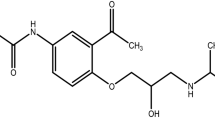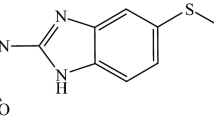Abstract
Pralidoxime chloride known as 2-PAM chloride is used as antidote for nerve agent’s poisoning. This study was undertaken to establish the compatibility of 2-PAM chloride with a number of commonly used excipients by using thermoanalytical technique viz., differential scanning calorimetry (DSC) and thermogravimetry/differential thermogravimetry (TG/DTG) used in pharmaceutical formulation. The TG and DSC both results demonstrated that polyvinyl alcohol, polyacrylamide, microcrestline cellulose, hydroxypropyl cellulose, cellulose acetate, ethyl cellulose found to be compatible with 2-PAM chloride and chosen for the preparation of antidote against chemical warfare agents.






Similar content being viewed by others
References
Reinaldo TD, Tatiana SR, Figueroa-Villar JD. Organophosphorus compounds as chemical warfare agents: a review. J Braz Chem Soc. 2009;20(3):407–28.
Organization for the prohibition of chemical weapons convention on the prohibition of the development production, stockpiling and use of chemical weapons and their destruction, technical secretariat of the organization for prohibition of chemical weapons (Organization for the prohibition of chemical weapons: the hague). 1997. http://www.opcw.org. Accessed 28 May 2008.
Luo C, Tong M, Chilukuri N, Brecht K, Maxwell DM, Saxena A. An in vitro comparative study on the reactivation of nerve agent-inhibited guinea pig and human acetylcholinesterases by oximes. Biochemistry. 2007;46:11771–9.
Bharate SS, Bharate SB, Bajaj AN. Interactions and incompatibilities of pharmaceutical excipients with active pharmaceutical ingredients: a comprehensive review. J Excip Food Chem. 2010;1(3):3–26.
Sharma R, Gutch PK, Ganesan K, Vijayaraghavan R, Jain S, Dubey S. Thermal analysis of interactions between an oxime and excipients in some binary mixtures by differential scanning calorimetry and thermagravimetric analysis. J Pharm Res. 2010;3(3):590–5.
Bertol CD, Cruz AP, Stulzer HK, Murakami FS, Silva MAS. Thermal decomposition kinetics and compatibility studies of primaquine under isothermal and non-isothermal conditions. J Therm Anal Calorim. 2010;102:187–92.
Pinto MF, Moura EA, Desouza FS, Macedo RO. Thermal compatibility studies of nitroimidazoles and excipients. J Therm Anal Calorim. 2010;102:323–9.
Neto HS, Barros FAP, Carvalho FMDS, Matos JR. Thermal analysis of prednicarbate and characterization of thermal decomposition product. J Therm Anal Calorim. 2010;102:277–83.
Ahmed TN, Abd El-Gawad H, Tawhida KG. Stability, bioavailability, and ulcerative activity of diclofenac sodium-mastic controlled release tablets. Drug Discov Therap. 2010;4(2):93–9.
Gombas A, Szabo RP, Kata M, Regdon G, Eros I. Quantitative determination of crystallinity of α-lactose monohydrate by DSC. J Therm Anal Calorim. 2002;68:503–10.
Gorniak A, Wojakowska A, Karolewicz B, Pluta J. Phase diagram and dissolution studies of the fenofibrate–acetylsalicylic acid system. J Therm Anal Calorim. 2010. doi:10.1007/s10973-010-1148-3.
Campanella L, Micieli V, Tomassetti M, Vecchio S. Quantitative determination of acetylsalicylic acid in commercial drugs using DSC. J Therm Anal Calorim. 2010;102:249–59.
Ahmed F, Gutch PK, Ganesan K, Vijayaraghavan R. N,N′-Dichloro-bis[2,4,6-trichlorophenyl]urea (CC2) and suspending agents used for the preparation of decontamination formulation against chemical warfare agents. A study of compatibility by thermoanalytical techniques. J Therm Anal Calorim. 2011. doi:10.1007/s10973-011-1583-9.
Fatima DFC, Flavio SAT, Flavio ADL, Moura FNR. Compatibility study between chlorpropamide and excipients in their physical mixtures. J Therm Anal Calorim. 2009;97:355–7.
Stulzer HK, Rodrigues PO, Cardoso TM, Matos JSR, Silva MAS. Compatibility studies between captopril and pharmaceutical excipients used in tablets formulations. J Therm Anal Calorim. 2008;91(1):323–8.
Banker SG, Rhodes CT. Modern pharmaceutics. 3rd ed. New York: Marcel Dekker; 1998, p. 305–318.
Jackson K, Young D, Pant S. Drug-excipient interactions and their affect on absorption. Res Focus. 2000;3:336–43.
Mura P, Faucci MT, Manderioli A, Ceccarelli L. Compatibility study between ibuproxam and pharmaceutical excipients using differential scanning calorimetry, hot-stage microscopy and scanning electron microscopy. J Pharm Biomed Anal. 1998;18:151–63.
Mura P, Faucci MT, Manderioli A, Furlanetto S, Pinzauti S. Thermal analysis as a screening technique in preformulation studies of picotamide solid dosage forms. Drug Dev Ind Pharm. 1998;24:747–56.
Verma RK, Grag S. Compatibility studies between isosorbide mononitrate and selected excipients used in the development of extended release formulations. J Pharm Biomed Anal. 2004;35:449–58.
Bruni G, Amici L, Berbenni V, Marini A, Orlandi A. Drug–excipient compatibility studies. Search of interaction indicators. J Therm Anal Calorim. 2002;68:561–73.
Filho ROC, Franco PIBM, Conceic EC, Leles MIG. Stability studies on nifedipine tablets using thermogravimetry and differential scanning calorimetry. J Therm Anal Calorim. 2009;97:343–7.
Misra M, Misra AK, Panpalia GM. Interaction study between pefloxacin mesilate and some diluents using DSC supported with isothermal method. J Therm Anal Calorim. 2007;89(3):803–8.
Valentina C, Mihaela M, Ioana S, Cristina M. IR spectral study on nature of 2-pyridine aldoxime methyl chloride interaction with some sterols. Revue Roumaine de Chimie. 2007;52(8–9):739–43.
Kuca K, Cabal J, Bajgar J, Jun D. In vitro searching for a new potent reactivator of acetyl cholinesterase inhibited by nerve agent VX. Lett Drug Des Discov. 2005;2:23–5.
Xiaohong P, Thomas J, Larry A. Quantitative measurement of indomethacin crystallinity in indomethacin-silica gel binary system using differential scanning calorimetry and x-ray powder diffractometry. AAPS Pharm Sci Tech. 2006;7(1): Article 11.
Author information
Authors and Affiliations
Corresponding author
Rights and permissions
About this article
Cite this article
Gutch, P.K., Jitendra, S., Alankar, S. et al. Thermal analysis of interaction between 2-PAM chloride and various excipients in some binary mixtures by TGA and DSC. J Therm Anal Calorim 111, 1953–1958 (2013). https://doi.org/10.1007/s10973-011-2100-x
Received:
Accepted:
Published:
Issue Date:
DOI: https://doi.org/10.1007/s10973-011-2100-x




